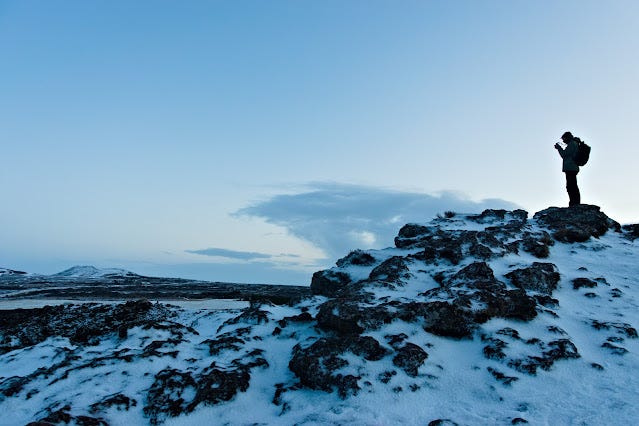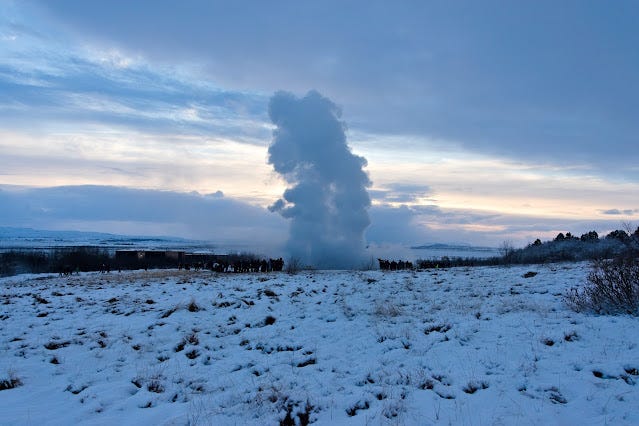Things to do in Iceland, Golden Circle
Geysir, Gullfoss and Thingvellir national park in winter
This is the second of four posts about my trip to Iceland, I spent there 10 days in December 2018. In this post, I will describe the Golden Circle, a popular circular route that leads you to some natural attractions. In the first post I talked about Reykjavik, and in the next ones, I will speak of the Reykjanes peninsula and the south coast with the black sand beach.
I participated in a volunteer work camp in Reykjavik and we celebrated New Year’s Eve there together with the other volunteers. I did some excursions to get to know the island, and the one to the Golden Circle is one of these. The volunteer organization offered us the opportunity to do these daily excursions paying a fee. We were leaving Reykjavik by car around 10 am and coming back maximum at 5 pm.
Iceland is an amazing place, nature at its best, here is where I started to practice photography and since then I never stopped.
Iceland
Iceland, known as "The Land of Fire and Ice," is a captivating island nation located in the North Atlantic Ocean. It's renowned for its stunning natural beauty and unique geological features.
Iceland boasts a striking juxtaposition of active volcanoes and sprawling glaciers. With a population known for its warmth and resilience, Iceland has also preserved a rich cultural heritage steeped in ancient sagas and modern creativity. From cascading waterfalls to vibrant cities, Iceland offers an unparalleled blend of natural wonders and vibrant culture that mesmerized me and for sure all the people who visit it.
Golden Circle
The Golden Circle is a popular tourist route in Iceland, known for its stunning natural attractions and historical sites. It's a circular route that covers approximately 300 kilometres (190 miles) and is easily accessible from Reykjavik.
The three main attractions on the Golden Circle are Thingvellir National Park, Geysir Hot Springs Area and the Gullfoss Waterfall. Each offers a unique experience showcasing Iceland's geological and historical richness. Along the way, you'll also find opportunities to explore smaller, equally captivating sites and enjoy the spectacular Icelandic landscape.
The Golden Circle is accessible year-round, conditions can vary depending on the season. Winter offers a snow-covered wonderland, while summer provides longer days for exploration. Regardless of when you visit, the Golden Circle is sure to leave you in awe of Iceland's natural beauty and cultural heritage.
I have to say that compared to the other two excursions I did, this was the one I enjoyed less, mainly because of the tourists, who made the places crowded. But this didn't impact on how amazing these places are.
Kerid Crater
The first stop of the tour was at the Kerið crater, which is not one of the main attractions of the Golden Circle but it is still a fantastic place to visit.
Kerið is a volcanic crater lake located in the Grímsnes area of southern Iceland. It is a striking geological feature, known for its vividly coloured, deep-blue lake nestled within the red volcanic rock of the crater walls. The contrast between the cerulean waters and the fiery rock creates a stunning visual spectacle.
The crater is estimated to be around 3,000 years old and is believed to have formed from a volcanic explosion. Over time, the walls of the crater have weathered and eroded, creating the distinctive bowl-like shape that visitors see today.
Kerið is easily accessible, with a pathway that leads around the rim of the crater, allowing visitors to take in the stunning views from various angles. Additionally, during the summer months, you can descend to the shores of the lake and even go for a gentle stroll along the water's edge.
As you can see from the pictures the moon was visible in the sky even if it was daylight. Usually, our excursions started around 10 am because at that time it was still dark but soon the sun was coming up, and the sunset was around 3/3:30 pm so the time to do the excursion was very little.
What makes Kerið particularly unique is that, unlike most volcanic craters, it contains a lake. The lake's depth fluctuates with the seasons, ranging from 7 to 14 meters (23 to 46 feet), adding to the crater's allure. Because of this, it was possible to play with the reflection of the lake, and that's what I tried to do, using also the snow and the winter colours. I saw some pictures from other periods of the year and the colours from the volcanic rocks give a completely different atmosphere.
Gullfoss waterfall
Gullfoss, often referred to as the "Golden Falls," is one of Iceland's most iconic natural wonders. It is a two-tiered waterfall located in the canyon of the Hvítá River in southwestern Iceland. It's known for its breathtaking beauty and powerful cascades, making it one of the most visited and photographed sites in the country.
The name "Golden Falls" is derived from the phenomenon that occurs on sunny days, when the glacial sediment in the water gives the falls a golden hue. This, combined with the roaring white water, creates a mesmerizing and almost magical sight.
The waterfall's upper cascade drops 11 meters (36 feet), while the lower one plunges 21 meters (69 feet), creating a dramatic and awe-inspiring spectacle. It is possible to get close to the falls, thanks to well-maintained viewing platforms and paths.
As it is one of the most famous wonders, there were a lot of tourists even in this cold period and the situation was chaotic. Anyway, I was still able to enjoy the wonderful waterfall.
Five minutes after we arrived it started to snow heavily, so it made it difficult to take pictures or even see the waterfall, but after a few minutes it stopped. I saw everything white and the good weather coming up, the sun behind the clouds after the snow. I liked the effect that the light coming up had, the red/yellow light mixing with the blue one from the snow.
The view of this canyon with this light was better than the waterfall itself, my best memory from this place.
Geysir Hot Springs Area, Haukadalur
The Geysir Hot Springs Area (Haukadalur), often simply referred to as Geysir, is a geothermal wonderland.
Geysir is renowned for being the namesake of all geysers worldwide. While the original Geysir has become relatively dormant, nearby Strokkur steals the show. It's a highly active geyser that erupts with impressive regularity, shooting a column of scalding water and steam up to 30 meters (98 feet) into the air.
This geothermal field is a bubbling cauldron of geysers, hot springs, mud pots, and fumaroles. The landscape is surreal, with steam rising from the ground, creating an otherworldly atmosphere.
The vibrant colours of the mineral-rich waters add to the area's visual appeal. You'll see various shades of blue, green, and orange, creating a stunning contrast against the stark Icelandic landscape.
The eruption from the first picture was caught randomly, I just arrived in the park, and I was looking in the right way at the right moment, I didn't know there was a geyser there.
Haukadalur is the name of a valley that lies to the north of Laugarvatn Lake. It is a place of geysers and more than 40 hot springs, mud pots and fumaroles. Haukadalur geothermal area was first mentioned in 1294 when local hot springs were activated by an earthquake.
For the second eruption I waited for the geyser, and the second attempt was a good one, but I think that the other picture, the lucky one, is better. I like this one because of the crowd waiting for the eruption.
The two eruptions in the pictures come from Strokkur, and it was the first time I had seen a geyser in my life, the area was surreal, the smell in the air, the eruptions and the hot fumes coming up from the ground, something to experience at least once in a lifetime.
Thingvellir national park
Thingvellir National Park is a place of immense historical, cultural, and geological significance.
Thingvellir is home to the Alþingi, one of the oldest parliaments in the world, established in 930 AD. This assembly of early Icelandic settlers played a crucial role in the development of the nation's legal and political systems.
Geologically, Thingvellir is a place of wonder. It's situated on the Mid-Atlantic Ridge, where the Eurasian and North American tectonic plates meet. In the last picture of this post, the drift is visible, it is a canyon and we walked through it to arrive at the viewpoint, if I remember well from this point the Eurasian plate is on the left and the American on the right.
The park is also endowed with stunning natural beauty, including rugged lava fields, dramatic cliffs, and the serene Lake Thingvallavatn. The landscape is a testament to the raw power of geological forces that have shaped Iceland over millions of years.
Thingvellir's combination of historical, cultural, and geological significance led to its designation as a UNESCO World Heritage Site in 2004. It remains a place of great pride for Icelanders and continues to be a popular destination for tourists seeking a deeper understanding of Iceland's rich heritage and natural wonders.
This waterfall from the first picture is one of the attractions of the national park, it flows from the Öxará River and it creates a pool at the base of the waterfall, filled with rocks, that can be iced during the winter. Here, as you can see, it was snowing, so it was not extremely cold. A funny thing is that I discovered that an edited picture of this waterfall was used by Nine Inch Nails for their cover of the album The Fragile.
The national park was used as a shooting location for Game of Thrones, for example, the gorge was the Gates of the Moon, the surrounding area for the fight between the Hound and Brienne of Tarth, and the lake Thingvallavatn was the bay from which Arya leaves from Westeros to Braavos.
A last fun fact was that because of the snow, I got lost with a small group of volunteers and we went in the wrong direction, fortunately after some time we realised it and we were able to get back to the main group, but because of this, we were able to walk in the Mid-Atlantic Ridge and take the last picture.
This was just an appetiser about Icelandic nature, as I said I didn’t enjoy this tour as much as I loved the others I did, but what I saw was amazing and it impressed me positively. In the next post, I will bring you to the Reykjanes peninsula, and I’m sure you will love it.
























